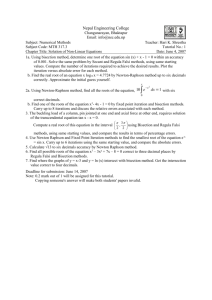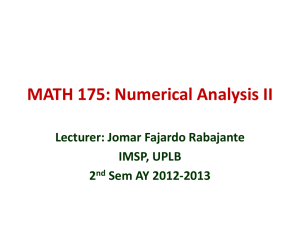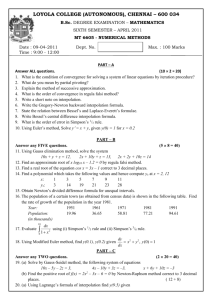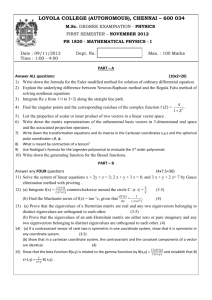A M O D I F I E D
advertisement
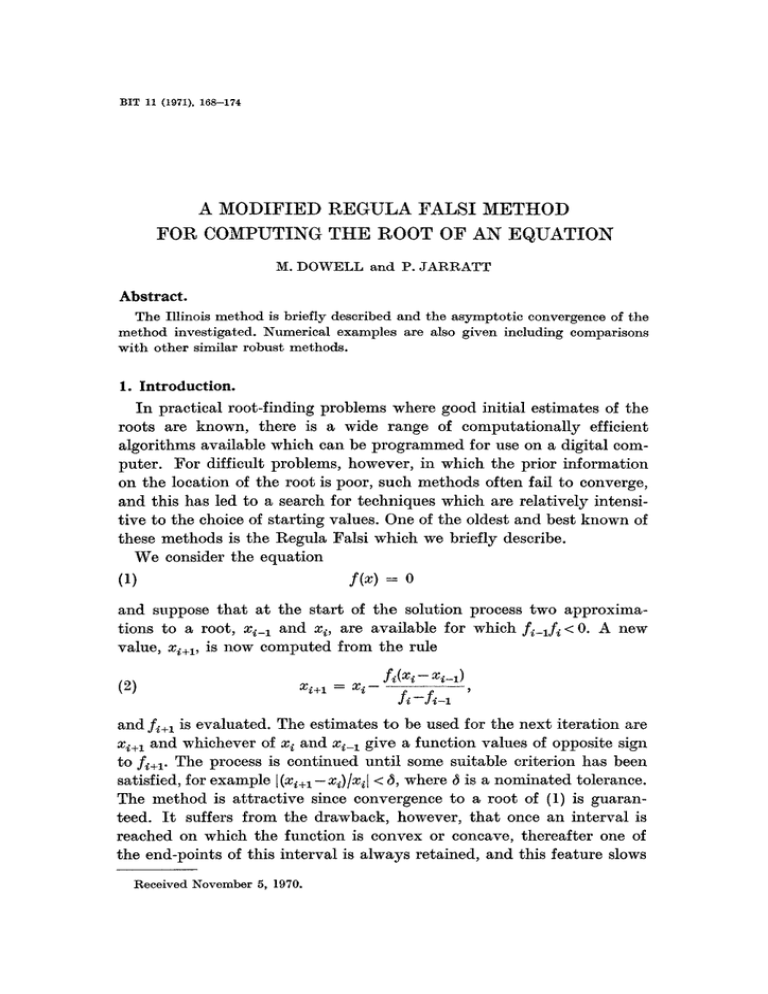
BIT 11 (1971), 168--174 A MODIFIED FOR COMPUTING REGULA THE M. DOWELL FALSI METHOD ROOT OF AN EQUATION a n d I ). J A R R A T T Abstract. The Illinois method is briefly described and the asymptotic convergence of the method investigated. Numerical examples are also given including comparisons with other similar robust methods. Introduction. 1. I n practical root-finding problems where good initial estimates of the roots are known, there is a wide range of computationally efficient algorithms available which can be programmed for use on a digital computer. For difficult problems, however, in which the prior information on the location of the root is poor, such methods often fail to converge, and this has led to a search for techniques which are relatively intensitive to the choice of starting values. One of the oldest and best known of these methods is the l~egula Falsi which we briefly describe. We consider the equation (1) f(x) = o and suppose t h a t a t the start of t h e solution process two approximations to a root, x~_1 and xt, are available for which fi-lfi < 0. A new value, x/+ 1, is now computed from t h e rule f i(xl -- Zi_l) (2) X +l = f -A-1 ' and fi+l is evaluated. The estimates t o be used for the n e x t iteration are xi+ 1 and whichever of x i and xi_ I give a function values of opposite sign to fi+l. The process is continued until some suitable criterion has been satisfied, for example [(xi+1 -x~)/xt[ < (~, where ~ is a nominated tolerance. The method is attractive since convergence to a root of (1) is guaranteed. I t suffers from the drawback, however, t h a t once an interval is reached on which the function is convex or concave, thereafter one of the end-points of this interval is always retained, and this feature slows R e c e i v e d N o v e m b e r 5, 1970. A MODIFIED REGULA FALSI METHOD FOR C O M P U T I N G . . . 169 down the asymptotic convergence to first order. We now describe a modification of the I~egula Falsi which leads to a considerable enhancement in speeed of convergence without the guarantee of convergence being lost. This refinement, which has now entered the folklore of computing, is thought b y some to have been due originally to the staff of the computer centre at the University of Illinois in the early 1950's. The present paper gives a theoretical analysis of the behaviour of this refinement and also reports some numerical experience with the process. 2. The Illinois algorithm. The method follows the Regula Falsi except that the estimates chosen for the next iteration are selected according to the following rules: i) if fl+lfi < 0, then (Xi_l,f~_l) is replaced b y (xi,fi) ii) if fi+lft > O, then (Xi_l,ft_l) is replaced b y (Xi_l,ft_l/2). As before, (xl+l,ft+l) replaces (xi,fi). The function values used at each iteration will again always have opposite signs and the introduction of the value fi_l/2 for fi-1 is a modification designed to speed convergence b y preventing the retention of an end point. We now analyse the asymptotic convergence of the method. For initial estimates x 0 and x 1 which are sufficiently close to a root 0 of (1), asymptotic error theory can be used to examine formally the behaviour of the algorithm. We begin b y defining the error in the ith approximation b y ei = x i - O , and using the Taylor expansion of fi about 0 we find fi = ~ c~i r, where c r = f(r)(O)/r! r=l and co =f(0) = 0. B y substituting in (2) it is easy to show that for a simple root C2 (3) 8t+1 '~ ~ ~i~i_l. The behaviour at the next iteration depends on whether ft+lft is less than or greater than zero. In the former unmodified case, b y straightforwardly applying (3) we shall have C2 El+2 ~ ~l~l+l~i while for the latter modified case analysis gives (4) el+~ ~ -~t+l. 170 M. DOWELL AND P. JARRATT B y using (3) a n d (4) it is n o w possible t o examine t h e a s y m p t o t i c itera t i n g p a t t e r n of the Illinois m e t h o d . A s s u m i n g t h a t et_ ~ is negative a n d ei positive, a n d t a k i n g first t h e case c~/c 1 positive, we find a sequence of values, calculated f r o m modified (M) a n d u n m o d i f i e d (U) iterations in t h e order U U M , U U M , U U M . . . . . F o r c~/c I negative, t h e p a t t e r n is U.M, U U A I , U U M , . . . , a n d in b o t h cases t h e basic p a t t e r n is one of t w o u n m o d i f i e d iterations, followed b y a modified one. F r o m (3) a n d (4) it can be s h o w n t h a t / c2"~~ ~ 3 t-4,) ' a n d if we designate the three iterations U U M error #, we find as a single iteration with /c2\ ~ 3 . H e n c e we h a v e a process which is t h i r d o r d e r a t a cost of three evaluations of f per step in t h e sequence. Accordingly, using T r a u b ' s (1, A p p e n d i x C) Efficiency I n d e x , we find t h a t t h e c o m p u t a t i o n a l efficiency of t h e Illinois m e t h o d is 33 = 1.442 . . . . c o m p a r e d w i t h a n efficiency of 1 for t h e u n m o d i f i e d R e g u l a Falsi. 3. N u m e r i c a l Illustrations. W e show first in Table 1 the b e h a v i o u r of the m e t h o d for the equation s i n x - 0.5 = 0. The root is 0 = z / 6 for which c2/cl = - t a n 0 = - 1/[/3, a n d we s t a r t with initial estimates x 0 = 0.0, x 1 = 1.5. Table 1. i 2 3 4 5 6 7 8 9 10 e~ 0.228 --0.895 × 10-1 0.666 × 10-2 0.160 × 10-a --0.152 × 10-s 0.702 X 10-8 0.308 X 10-13 - 0 . 3 0 8 × 10-18 < ½X 10-18 Iteration U M U U M U U M U F r o m the table it is clear t h a t ee ~ - e s , e9 ~ - e s , illustrating the effect of the modified iteration. A MODIFIED I~EGULA FALSI METHOD FOR COMPUTING... 171 W e n o w u n d e r t a k e a n u m e r i c a l c o m p a r i s o n of t h e p e r f o r m a n c e of t h e Illinois m e t h o d w i t h those of a n u m b e r of c o m p e t i t i v e r o b u s t m e t h o d s . T h e a l g o r i t h m s chosen for c o m p a r i s o n were t h e R e g u l a Falsi, a l r e a d y described, the well-known Bisection a l g o r i t h m (1), a n d a h y b r i d m e t h o d f r e q u e n t l y used a n d f o r m e d f r o m a c o m b i n a t i o n of t h e R e g u l a Falsi a n d t h e Bisection a l g o r i t h m . H e r e a similar a p p r o a c h to t h e Illinois m e t h o d is a d o p t e d e x c e p t t h a t for t h e case f/+ifi > 0, the n e x t v a l u e is t a k e n as (xi_l+xi+l)/2, a g a i n p r e v e n t i n g t h e r e t e n t i o n of a n end point. I n a n a t t e m p t t o c a r r y o u t t h e c o m p a r i s o n o v e r as r e p r e s e n t a t i v e a class of p r o b l e m s as possible, a n u m b e r of e q u a t i o n s were c o n s t r u c t e d which possess characteristics c o m m o n l y e n c o u n t e r e d in root-finding p r o b lems. I n each case t h e f u n c t i o n used possesses a p a r a m e t e r n w h i c h can be v a r i e d to give a f a m i l y of curves of the s a m e t y p e . T h e calculations were p e r f o r m e d in double precision a r i t h m e t i c a n d t e r m i n a t e d w h e n If(x)I < 0 . 5 × 10-1% All t h e roots lie in t h e r a n g e [0,1] a n d a p a r t f r o m T a b l e 7 t h e s t a r t i n g values x 0 = 0, x I = 1 were used in e a c h case. T a b l e 2. f(x) = 2xe -n + 1 - 2e -nx. No turning points or inflexions on [0,1]. Number of Iterations 1 5 15 20 Bisection Regula Falsi 64 64 67 67 23 40 41 42 l~egula Falsi + Bisection 19 21 23 23 Illinois 9 10 11 11 T a b l e 3. f ( x ) = (1 + (1 - n)2)x - (1 - nx) ~. One turning point on [0, 1]. Number of Iterations Bisection 2 5 15 20 64 62 71 71 Regula Falsi 25 16 11 10 Regula Falsi + Bisection 21 17 15 15 Illinois 3l. DOWELL A N D P. JARRATT t72 T a b l e 4. f(x)=x~-(1-x) n. One inflexion on [ 0 , 1 ] . N u m b e r of I t e r a t i o n s n Bisection Regula Falsi 2 1 1 5 15 20 64 61 62 54 179 245 f(x) = T a b l e 5. Regula Falsi + Bisection 1 19 23 23 Illinois 1 8 11 12 n)4)x - (1 - nx) 4. One turning point anzl one inflexion on [ 0 , 1 ] . (1 + (1 - N u m b e r of I t e r a t i o n s ~b 2 5 15 20 T a b l e 6. Bisection Regula Falsi Regula Falsi + Bisection Illinois 64 71 76 77 40 9 6 5 21 13 9 9 10 7 6 6 f ( x ) = e-nX(x- 1 ) + x "~. A f a m i l y of curves which lie increasingly close to the x-axis for large n. N u m b e r of I t e r a t i o n s 1 5 10 15 Bisection Regalia Falsi Regula Falsi + Bisection Illinois 64 63 57 55 26 114 1286 > 104 19 21 23 21 9 9 13 16 A MODIFIED REGULA FALSI METHOD FOR COMPUTING... 173 Table 7. f(x)= ( n x - 1 ) / ( ( n - 1)x). A family of curves with the y-axis asymptotic. Number of Iterations Bisection Regula Falsi gegula Falsi + Bisection Illinois 59 56 61 58 2008 809 262 192 2 25 25 25 14 14 14 15 n 2 I 5 15 20 T h e starting values used here were Xo=0.01, x l = 1.0. F r o m these tables it is clear t h a t t h e Illinois m e t h o d is consistently superior, in m a n y eases completing t h e calculation in fewer t h a n half the n u m b e r of iterations required b y the n e x t best method. 4. Algol procedure. W e give finally an A L G O L p r o c e d u r e for i m p l e m e n t i n g the Illinois algorithm. real p r o c e d u r e Illinois(f, x, xO, xl, delta); real f, x, xO, x l , delta; value xO, xl, delta; c o m m e n t This procedure carries out the Illinois iterative process to find a root of f(x)= O, given two approximations xO and xl which must be chosen such that f(xO) a ~ f ( x l ) are of opposite sign; begin real f0, f l , fx; x:= xl;fl:--f; x := x0;f0 := f; for x : = x l - f l x (xl - x O ) / ( f l - f O ) while a b s ( x - x l ) > delta do begin fx:=f; if fx × f l < 0.0 then begin x o : = xl ; f o : = f I end else f 0 : = f 0 x 0.5; 174 •. D O W E L L AND P. J A R R A T T xl := x; f l := fx end of iterative loop; Illinois := x end of procedure Illinois; REFERENCE J . F. T r a u b , Iterutive Methods for the Solution of Equations, P r e n t i c e - H a l l , E n g l e w o o d Cliffs, N . J . , 1964. COMPUTING LABORATORY UNIVERSITY OF BRADFORD ENGLAND
